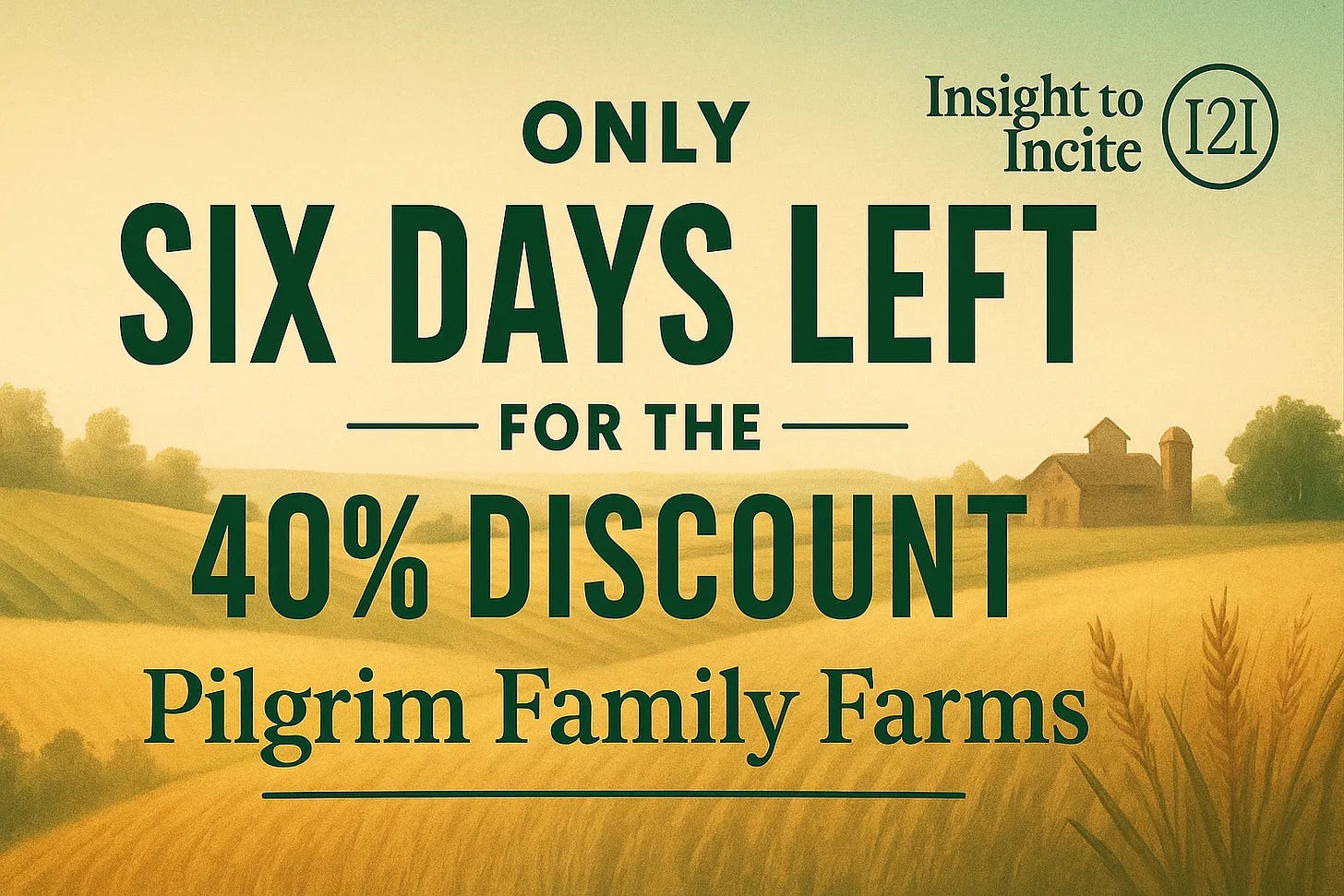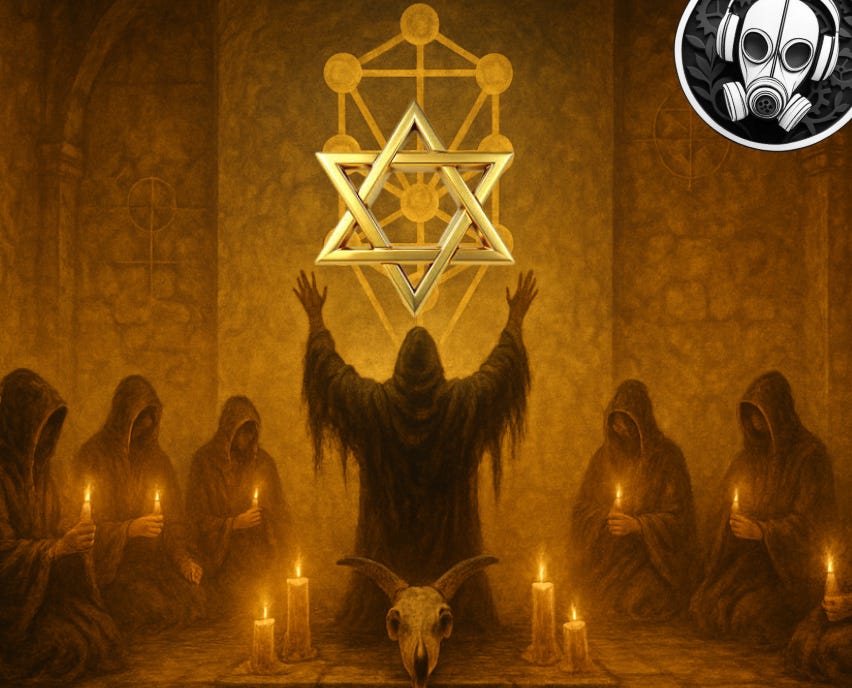Not Every Fact is a Slur: Understanding the Star of David and the Star of Rephan
The symbol does indeed have roots in the Occult. That fact might surprise you (but it shouldn't offend you).
On X yesterday, a familiar thunderclap rolled across the timeline. Eric Metaxas cried foul when Candace Owens likened the Star of David to an occult symbol. The accusation landed like a thrown rock, and the replies turned into a village square at noon. I have spoken positively of Metaxas over the years and I mean it. I have also complained when he could not see that some of his friends in Big Eva were the problem with evangelicalism, not its solution. He still deserves credit where it is due. He was the first member of the Evangelical Immigration Table to denounce it, and over the years he has promoted my work at Protestia and Insight to Incite (by that I mean, he’s shared it).
That said, not every historical fact you dislike is antisemitic. Calling something occultic because of its documented pathway through esoteric traditions is not a slur against a people. It is a claim about symbols, timelines, and ideas. That is the lane for this piece. The Star of David as a pan-Jewish emblem is a late development, and its earlier appearances are tied to streams most modern readers would call magical or esoteric. When we read Scripture, the prophetic rebukes about star worship and Israel’s flirtation with rival deities take on a sobering clarity. If you want the truth, follow the texts and the timelines rather than the hashtags.
REPHAN, MOLECH, AND ISRAEL’S LONG TEMPTATION
The Bible mentions the Star of Rephan twice, once in the voice of the prophet and once in the mouth of a martyr. Amos warns Israel, “You took up Sikkuth your king and Kiyyun your images, the star of your god which you made for yourselves.”
Stephen quotes that oracle before the Sanhedrin, sharpening the point. “You took up the tent of Moloch and the star of your god Rephan, the images that you made to worship.” The pairing is deliberate. Israel carried the portable shrine of a detestable god and the star emblem of a pagan power, and the Lord promised exile because of it. The ancient tradition connects Rephan with a planetary deity, most often Saturn. The text does not sketch the geometry of the star, yet it records a fact that matters. God’s people borrowed a star icon from a rival cult and the prophets called it what it was.
The name of Molech drags a long chain through Israel’s history. This was the Canaanite abomination that demanded what no father should ever give. The law forbade it, the prophets exposed it, and yet the people kept circling back. That is the ugly truth about idolatry. It is not content with one visit. It returns and asks for more. The star of a foreign power functions in that story as a badge of spiritual drift. You see the tent and the star and you know what is happening beneath them. The God of Abraham gives a covenant sign that marks His people for life. The nations brand themselves with the sky gods and march to a different calendar.
This is why the prophetic critique bites. Israel had the light and still picked up the trinkets of the dark. They did not run to philosophy. They reached for images. They carried portable power. They made what they worshiped and then were remade by what they carried. When Stephen brings Amos into the courtroom, he is not doing antiquarian trivia. He is reading the heart. Golden calf, high places, star of Rephan, tent of Molech, it is a single line of rebellion that dresses itself in ornaments and calls the costume devotion

HEXAGRAMS BEFORE THE MAGEN DAVID
The six pointed star is not a modern invention. The hexagram appears across antiquity as a simple geometric figure with many uses. It shows up in Near Eastern seals, in Greco-Roman mosaics, and in magical papyri where it functions as a sign of protection or power. In South Asian contexts it develops other layers of meaning. In late antique and medieval Mediterranean materials it is often paired with its five pointed cousin under the umbrella name Seal of Solomon. Islamic and Jewish magical texts alike use that phrase. The figure could be etched on amulets, drawn on bowls, or inscribed on rings that promised command over spirits. The point is not to smear people by association. The point is to admit the obvious. A six pointed star was a common diagram in the premodern world and it frequently traveled with occult claims.
What did Israelites know? From the exile onward they lived under empires that trafficked in astral cults. Babylonian religion mapped the heavens into a calendar of powers. Saturn had a cult. Venus had a cult. The language of star worship and planetary lords is baked into the region. When Amos and Stephen talk about the star of a god, they are not guessing, they are naming a real thing. Whether the emblem in question was a hexagram or another star figure, the operating system is the same. Borrow the star, borrow the liturgy, borrow the bondage.
Now zoom ahead to Jewish usage. You will search in vain for widespread, continuous, pan-Jewish deployment of the hexagram as a Davidic emblem in antiquity. Sporadic appearances exist, largely decorative or apotropaic. The dominant mark of Jewish identity for centuries was the menorah, not a six pointed star. When hexagrams appear in Jewish contexts before the early modern period, they often live in the same neighborhood as protective charms, micrographic art, or Kabbalistic diagrams. The figure was part of the common esoteric toolkit of the medieval world. It did not function as the standard badge of the synagogue, and it certainly was not the banner of Israel.
What about the claim that the Star of David is ancient and biblical? The phrase Magen David means Shield of David and appears in later literature as a devotional metaphor. It does not refer to a geometric emblem in Scripture. You can love King David, pray the psalms, and still admit that the six pointed star rose from a very different stream. The fact is, the emblem known now as the “Star of David” is indeed an image of the occult, and just so happens to be identified with a particular form of demon worship the Israelites were repeatedly scolded for in the Bible.
FROM KABBALISTIC EMBLEM TO MODERN BANNER
If you map the actual rise of the six pointed star as a Jewish community emblem, you land late. The symbol’s prominence is early modern, then modern, then global. You can point to earlier local adoptions, but the banner effect is not medieval and it is not biblical. It is the child of printing, municipal heraldry, and the rise of Kabbalistic and magical corpora that loved geometric seals. Kabbalah is not a slur. It names a body of literature that grew out of medieval Jewish mysticism, that absorbed Neoplatonic and Hermetic currents, and that generated diagrams, amulets, and ritual names intended to manipulate unseen realities. That is what any fair minded reader means by occult. It deals in hidden powers and ritual technique.
Within that literature the hexagram and pentagram flourish as Seals of Solomon. They appear on amulets meant to ward off demons, on ritual objects, and in grimoires that promise mastery. The star becomes a preferred badge not because Moses commanded it, but because late medieval esotericism loved it. From there the figure migrates into civic life in places where Jewish communities adopt a distinctive seal, sometimes at the invitation of Christian magistrates who want an emblem for guilds and quarters. Once the symbol starts showing up on communal flags and synagogue décor, the feedback loop begins. What was once one of many esoteric motifs begins to look like our sign.
The nineteenth century finishes the transformation. As Jewish nationalism takes institutional shape, the hexagram becomes a convenient, recognizable emblem to print, sew, and rally around. It is clean, symmetrical, and already familiar as a Jewish marker in central Europe. The Zionist movement takes the path of least resistance. What had traveled through the magical handbooks and Kabbalistic diagrams becomes the logo on a flag. Modern memory backfills a story. The real path is more complicated and more recent.
None of this licenses hatred toward Jews or toward Israel. Symbols can be reassigned. Meanings shift. Communities adopt and sanctify. The Roman cross that once meant pagan execution now sits on every steeple. The problem is not the geometry. The problem is pretending that a late adoption is a Moses-era command. When the Bible warns about picking up the star of a rival god, it is not giving us a museum label. It is telling us how symbols can smuggle in stories and stories can smuggle in loyalties.
So what do we do with a controversy where a pundit calls an emblem occultic and a popular author calls foul. We tell the truth with clean edges and clean motives. We refuse the lazy charge of antisemitism when the claim is about texts and timelines rather than people. We refuse the lazy triumphalism that pretends a late mystic emblem is a covenantal requirement.
WHAT KABBALAH IS AND WHY CHRISTIANS CALL IT OCCULT
Kabbalah is not a synonym for Jewish piety or biblical wisdom. It is a medieval mystical system that claims hidden layers in Scripture, secret names of God, and ritual techniques that promise access to supernatural power. Its classic texts emerge long after the biblical canon closed. The Zohar appears in the late thirteenth century. The Lurianic school in sixteenth century Safed systematizes mythic doctrines about divine emanations, cosmic shattering, and human rituals that repair the universe. Kabbalah interprets the world through sefirot, ten emanations that map the flow of divinity into creation. It assigns extraordinary potency to letters, numbers, and permutations of sacred names. It encourages the use of amulets, incantations, and meditative practices that manipulate these names for protection, healing, or influence.
From a Christian vantage point that is not spirituality in the sense of prayerful dependence on the living God. It is technique. It treats the holy Name as a mechanism and the universe as an engine that can be tuned by adepts. That is why serious Christians describe it as occult. Occult does not mean sinister costumes. It means the pursuit of hidden power through secret knowledge and ritual means rather than humble faith and covenant obedience. When a system assigns salvific weight to coded numerology, ritual talismans, and esoteric maps of heaven, Christians recognize the same pattern that Scripture condemns under the names of sorcery, divination, and trafficking with spirits.
Kabbalah habits crossed from study halls into folk religion. Protective amulets proliferated. Charms inscribed with divine names appeared on cradles and doorframes. Magical bowls and seals that promised mastery over spirits traveled across communities. Some rabbis pushed back. Others integrated selected practices into a wider piety. The long result is a body of mystical lore that many Jews regard as treasured heritage and that Christians must judge by biblical categories. Test the spirits. Refuse techniques that treat God like a lever. Reject any path that bypasses repentance and faith in the Son of God for ritual mastery of unseen powers.
HOW KABBALAH AND TALMUDIC JUDAISM SHAPE MODERN ISRAELI RELIGION
The religion of the Hebrew Bible is not identical to the rabbinic system that crystallized after the Temple fell. In fact, it’s not similar at all. That is a matter of historical record, not insult. The Mosaic economy centered on sacrifice at a single sanctuary, priestly ministry at an altar, and a calendar ordered around pilgrim feasts in Jerusalem. Rabbinic Judaism arose in a world without an altar and without a king. It built fences around the law, canonized oral traditions, and created a synagogue centered life governed by halakhic codes, legal argument, and the authority of learned judges.
That rabbinic frame is the backbone of contemporary Orthodox Judaism. Inside that frame Kabbalah entered, first as a controversial current, then as a major river. Medieval and early modern mystics stamped liturgy, customs, and sensibilities that are now common. Friday night hymns like Lecha Dodi come from Safed. Practices such as Kabbalat Shabbat, late night lamentations on the Ninth of Av, and customs around marriage and mourning carry Kabbalistic fingerprints. Hasidic movements built popular piety around mystical devotion to a charismatic rebbe, with tales of miracle and intercession that draw directly from Kabbalistic myth of divine sparks and tikkun olam long before that phrase was secularized.

Modern Israeli religion reflects this blend. Israel is religiously diverse. There are secular Israelis, Reform and Conservative Jews, and a wide spectrum of Orthodox communities. The state’s official religious establishment is rooted in rabbinic law. At the same time Kabbalistic motifs are not fringe. They live in music, poetry, ritual, and the spiritual air of many communities. In some neighborhoods a mezuzah is also a talisman. In some synagogues prayers are augmented by mystical intentions and letter permutations. In some homes the bookshelf holds law codes beside Zohar. That is not a smear. It is description. The Judaism of the Tanakh is the seed. Rabbinic halakhah is the mature tree. Kabbalah is a graft that has grown thick rings across the last seven centuries.
Would Moses or David recognize the religion now practiced by many Israelis as their own? They would recognize the Scriptures, the songs, and the passion for the God of Abraham. It’s possible they would recognize parts of the spoken language (Hebrew was read, but as a spoken language had to be reinvented at the establishment of the Israeli nation, in the same way we aren’t sure what Koine Greek sounded like, and we’re winging it).
They would also stare in confusion at large portions of the devotional world. There is no Temple altar. There is no Levitical choir in Zion. There are codes, commentaries, fences, and mystical systems that did not exist in their day. The Sanhedrin is gone, replaced by rabbinate offices. The sacrifices of bulls and goats were fulfilled in Christ, yet that truth is not confessed. Instead there is a halakhic maze built to make exile survivable. There are Kabbalistic ladders built to climb into heaven by syllable and symbol. From a New Testament perspective neither is the path that the apostles preached. That is not a cruel judgment. It is the baseline Christian claim that the old covenant was a tutor and that the revelation of God has been given in His Son.
WHY CHRISTIANS NAME IT PLAINLY
Christians are not obligated to defend any religion that denies the deity of Jesus Christ and the gospel of His cross and resurrection. We are commanded to love our neighbors, pray for the peace of the city, and do good to all. We are not commanded to baptize theologies that contradict the apostles. When a tradition elevates human precepts to the level of divine command, we say so. When a mystical current treats sacred names like tools and assigns salvific value to secret techniques, we say so. When a national religious establishment rests on law codes that replaced the Temple and rejects the Messiah who fulfilled it, we say so. The duty is to speak the truth with clean hearts. That means no slurs and no malice. It also means no euphemisms.
This clarity does not erase political prudence or civic solidarity. Christians can defend the dignity and safety of Jewish neighbors without endorsing Kabbalah or rabbinic claims. We can oppose antisemitism while refusing to flatter doctrines that deny the Son. We can support the right of a nation to live in peace while telling the truth about the spiritual map and the destination we confess. The early church did that in a world of synagogues and temples. We can do it in a world of parliaments and airbases.
A WORD FOR METAXAS
Eric Metaxas has done good work and has taken courageous public stands. That buys him respect. It does not buy him a pass. Before staging a public scolding of Candace Owens, he should have checked the record. The six pointed star did not serve as a biblical covenant emblem. It grew inside an esoteric tradition that Christians rightly call occult. It moved from Kabbalistic diagrams to communal seals to a modern banner. That is not antisemitic. It is a timeline.
If Metaxas wants to defend Jewish people from unjust attacks, he will find allies. If he wants to police the conversation by treating every reference to Kabbalah’s occult content as bigotry, he is wrong on the facts and unhelpful to the truth. Christians should be the last people to accept struggle session tactics that shame questions rather than answer them. We are people of a revealed Word. We do not protect faith with fragile narratives. We protect people with courage and we honor God with accuracy.
The next move is simple. Say plainly that Kabbalah is a mystical system that Christians must reject. Say plainly that rabbinic religion is not the Mosaic economy and that it has been further shaped by Kabbalistic currents. Say plainly that Jesus is Lord and that no religion that denies Him can be safe for souls. Then love your Jewish neighbor. Tell him the gospel. Refuse the lazy hatred that stalks this subject. Refuse the lazy flattery that sells out the truth. Speak like a Christian who knows the difference between compassion for people and endorsement of error. That distinction will keep your heart clean while your mind stays clear.
If you appreciate my work, slapped together on a Saturday afternoon because of a social media skirmish, you’ll love my more thoughtful, daily posts. Please grab a paid subscription to access exclusive content.
If you don’t do subscriptions, please consider a one-time gift of your choosing by clicking the ‘coffee link’ below.






You write with knowledge and skills I usually encounter in only nineteenth century writers. Having read much of your work since I signed up with Insight to Incite last month I am amazed at depth and diversity of your essays and find them profitable. Often, I find myself perplexed with observation within the religious and historical concepts of today and cannot spare the time necessary for clarification. For this I thank you.
“You took up the tent of Moloch and the star of your god Rephan, the images that you made to worship.” It would help if you would identify which book you are using. Amos 5:26 reads differant depending on which book you are quoting. see Acts 7:43